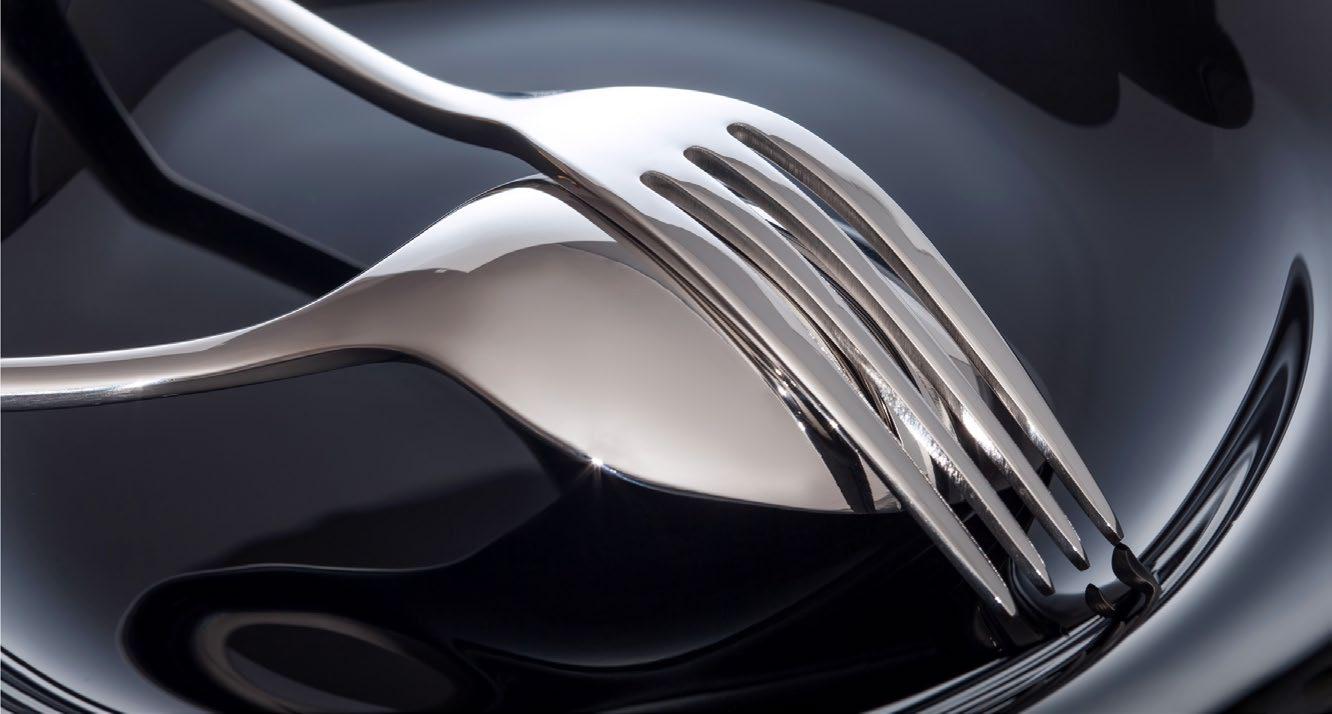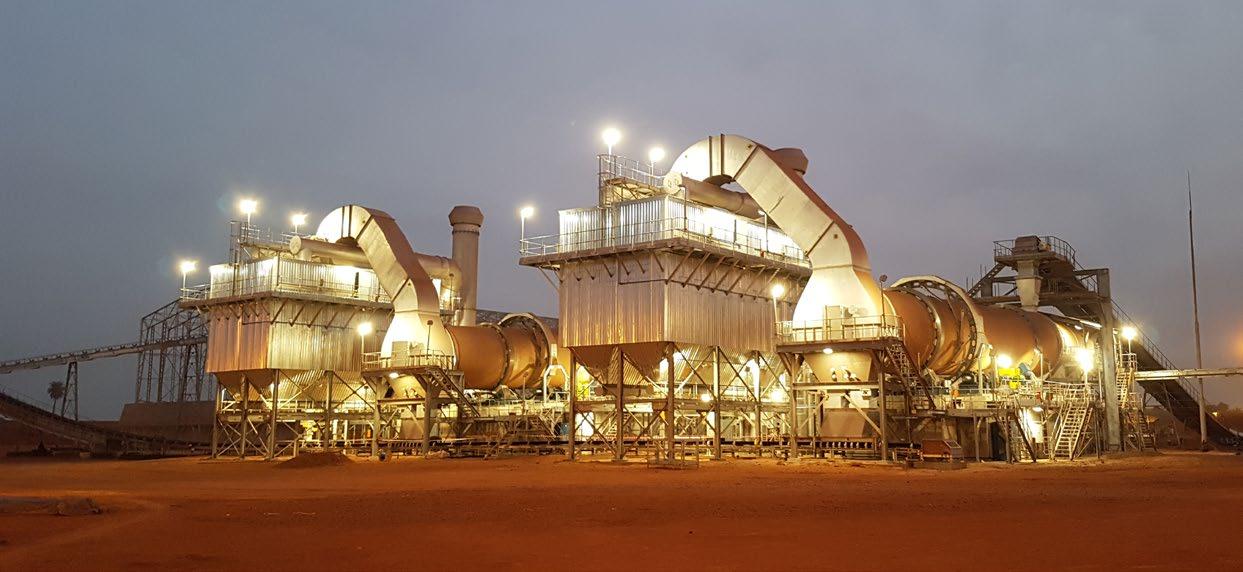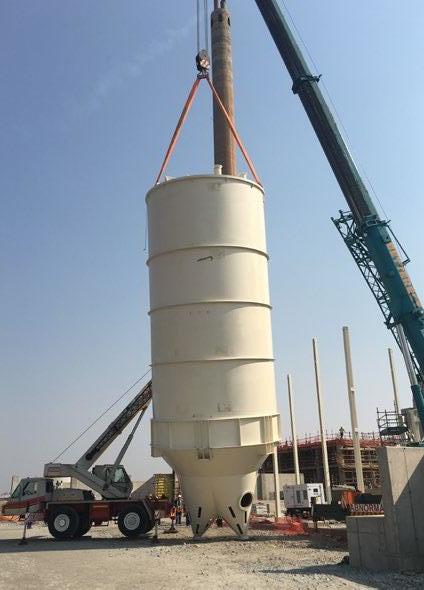
10 minute read
sector focus: Holloware
SUPPLY CHAIN GAINS MEAN IT’S HOLLOWARE’S TIME TO SHINE

Can the Epidemic lead to growth in the local Holloware Industry? When South Africa’s 58-million strong population commemorated Heritage Day this year, for the most part it was celebrated around a shared meal with family and friends while under COVID19’s Lockdown Level 1 protocols.
Yet, despite a current market demand for cookware, South Africa’s stainless steel holloware (pots and pans) and flatware sectors (cutlery, trays and serving dishes) are facing an undetermined future; with local manufacturers compelled to import their stainless steel to benefit from competitive pricing; and local retailers preferring to source, stock and sell imported products from the East.
With the sudden shifts in global trade regulations and health restrictions brought about by the epidemic, the traditional supply chains, import and export controls, and manufacturing models have been disrupted.
The question now lies as to how the future can be transformed through localisation, government and regional policy, and robust business growth strategy for growing the potential for local production, distribution, and extended export markets into Africa? POSITIVE MOVES According to Sassda Market Intelligence and Exports Specialist, Lesley Squires, the local holloware manufacturers will be feeling the market effects of the epidemic, but this will be dependent on the market demand for the range of products which the manufacturer supplies to market.“We are, however seeing some positive moves in the development of the local sector, for example, AMC Holloware has remained consistent as their products have a solid heritage within the local market and are therefore a popular family and wedding gift item. “Another local producer
Hendler & Hart have also engaged in an intensive18-months revamp of their manufacturing facility. With a new plant and equipment, they expect to start production shortly with the relaunch of their Aloe brand.”
According to Squires, the biggest obstacle facing local development is cheap imports into the market. “Despite the SABS specifying stainless steel grades 304 and 430 in all holloware products sold locally, many imported products are made from cheaper stainless variants. This means there are large quality variances in the holloware products sold in South Africa, which consumers only discover when they start using a product and experience substandard performance.”
On a more positive note, in terms of future areas of growth for the holloware sector, Squires reports that the government’s Steel Master Plan is currently looking at the designation of local hollowware products. This would mean that state institutions such as prisons, hospitals and schools would be required to use these products.
Looking further afield, African export markets also still represent a lucrative market with Sassda members operative in Tanzania, Kenya and the coastal regions of Mozambique supplying the hospitality sector with room for this aspect of their export sales to grow.
LOCAL MUST BE LEKKER! For local manufacturer Le Morgan, that manufactures a range of exclusively designed cookware products, they choose to follow a growth strategy within the current evolution of their company.
Having already rallied against and realised growth within local market challenges, Le Morgan CEO Graham Morgan says,” There is a huge potential market that could support job creation in local holloware manufacturing, but there are also many challenges still to be faced. With no support or benefits available from within the industry, we have managed to establish ourselves independently; to the extent that we are now at the stage where we are moving to larger premises.
“Unfortunately, we have been forced to import raw materials which are cheaper than buying from local agents. If local manufacturers continue to be ignored by South African retailers, very few manufacturers of hollow cookware will survive this period.”
Le Morgan can attribute most of their success to a direct supply chain

to consumer demand thereby cutting out the middleman. In 2018, they were also pre-emptive in supporting this demand by importing several new pressing machines, washing tunnels and polishing machines to speed up their manufacturing process.
“We have recently introduced five new designs of aluminium cookware sets to launch before the end of this year, which will immediately create new jobs for the Stanger area in KwaZulu-Natal,” confirms Morgan.
The company is also set to explore the lucrative export market opportunities into the rest of Africa and have plans to display its products at global trade shows by the end of 2021.
With aspirations to not only see growth in their manufacture of highquality stainless steel cookware, the company has also started redeveloping their processing in their aluminium range, moving from brazing aluminium bases to impact bonding. With a completely new set of tooling for highquality cookware sets and a cheaper range of tooling for a budget range of cookware onboard, Le Morgan also announced the launch of their new website this month.

‘NO FLASH IN THE PAN’: Betterect and DryTech International achieve a trio of mineral concentrate drying plant successes
Betterect, a South African fabricator and erector of large processing equipment structures, undertakes steel fabrication projects within the mining, petrochemical and other industries, for clients as far afield as Austria, Italy, Germany and Australia, as well as throughout Southern and Central Africa. With more than four decades in the industry, they are the recognised leaders within their field.
As such, Betterect has conceptualised and developed the ‘Team Africa’ concept, in which steel industry suppliers and manufacturers join forces and share skills and expertise to supply mining, power generation, industrial and other sector projects throughout Africa, thereby enhancing commercial activity and boosting economic growth on the continent.
A keen participant in this concept is DryTech International, which was established in 1983 and is a world leader in mineral concentrate drying, as well as supplying robust and durable processing equipment. Through their extensive pilot plant facilities, DryTech offers a range of innovative, productive and efficient high-tech engineering solutions for the drying and processing sectors of a variety of industries — both locally and internationally —including fine chemicals and polymers, web and textiles, pulp and paper and biomass sectors; and also specifically, for many key mines around the world.
Recently, DryTech International commissioned Betterect to undertake the fabrication of a flash drying plant on a South African platinum mine, as part of the mine’s objective to increase production.
Francois Herbst, Project Engineer at Betterect points out: “Betterect has partnered with DryTech International previously and we enjoy an excellent relationship, which has seen us achieve several flash drying plant project successes since our first collaboration.” Juan Horstmann, General Manager of DryTech International underscores Herbst’s observation: “We are no stranger to Betterect’s expertise and since 2016, have collaborated on no less than three flash drying plants on mines both locally and in Africa, using our combined skills to achieve excellent results for our clients.”
Betterect’s fabrication processes are renowned for their adherence to the strictest standards of production. The company has also invested substantially over the past five years in the latest pulse arc welding technology, which assures excellent weld technology while reducing welding time.
“The flash drying plant was fabricated from mild steel at our workshop in Chamdor, Krugersdorp, with all manufacturing executed according to stringent quality assurance and project management protocols, in accordance with ISO 3834 part 2 standards. Betterect also undertook transport to site, and installation of the flash drying plant on site.”
Herbst describes the previous
collaborations in more detail: “On a local platinum mine project in 2016/2017, Betterect undertook the detailed drawings, fabrication, rigging, installation and transportation of the flash drying plant, which was manufactured predominantly from mild steel with stainless steel handrails and gratings. We also conducted a tandem lift of the product dry bin - with dimensions of 5 x 12 metres - using our own 160-ton and 20-ton cranes, onto the abnormal load flatbed vehicle for transportation to site.
“For a project in Zimbabwe, a fluid bed combustor upgrade was required, comprising mild steel fabrication. Betterect fabricated and installed this; while for a project in Rustenburg, a retrofitted flash dryer was refurbished by Betterect, using mild steel.”
True to Betterect’s exceedingly high standards, on each project, all fabrication took place according to the most stringent fabrication standards criteria in its Chamdor facilities in Krugersdorp, Johannesburg.
“This type of close teamwork is what gives Betterect and its partners a competitive edge when undertaking projects locally and in Africa — for both local and international clients alike - while practising the true ethos of the ‘Team Africa’ concept,” Horstmann adds.
“This level of expertise and professionalism is why Betterect is our preferred installer and fabricator,” Horstmann remarks, emphasising that it is this consistent service which is also beneficial to them as a client, giving them confidence in the quality and reliability which Betterect stands for.
Horstmann says: “DryTech International’s developments and advances over the past 39 years have made us experts in process design and nothing is a case of ‘one-size fits all’, as every drying plant we develop is bespoke, down to the finest details. In essence, there are no ‘catalogue’ or off the shelf items. It is this ethos which has ensured significant repeat business for us as a company – such as the three platinum mine flash drying plant projects we undertook with Betterect.” He explains that furnaces and smelting operations require bone dry, freeflowing concentrate for material transport and injection into furnaces. Therefore consistent, reliable, and fully automated mineral concentrate drying has become a key requirement for every smelting operation.
“DryTech International’s profound knowledge and understanding of the concentrate drying process ensures that, in addition to being cost-effective, these criteria are met; and, in collaboration with Betterect’s all-round expertise and specialised fabrication, the recipe for success is a given when designing and delivering bespoke flash drying plants,” Horstmann notes.
With a small, tight and efficient team of 30 people, including design and process engineers, DryTech International has created a paradigm shift in the drying of mineral concentrate within the mining sector - as the flash drying process is not only exceedingly fast, affording favourable turnaround times -but also highly effective, impacting positively on production, he adds.
“To achieve all this, we share the workload with the fabricator; and, as both companies are ISO-certified and design and fabricate flash drying plants to fall within the legal emissions requirement — determined by the Department of Mineral Resources (DMR) in South Africa, and specified by whatever country we are manufacturing for — we have absolute confidence in our teamwork,” he adds. Betterect fabricated all three flash drying plants in accordance with the detailed drawings supplied by DryTech International.
“The actual flash drying process happens within 30 seconds, and in minerals specifically, we aim at attaining less than one percent moisture in the concentrate. This process takes place at between 600˚C and 700˚C,” Horstmann points out. All platinum ore is ‘wet feed’ material, he explains and therefore requires intense drying — which in turn, translates into high power consumption and increased cost — to achieve this.
“However, through our many years in the industry, we have developed a highly efficient feed management method for attaining the optimum drying result, using the least power, while expediting the process. By combining already dried concentrate

with the material that requires flash drying, the dry material circulates, and the concentrate is dried faster, using less power, in a shorter time, to achieve the best result,” Horstmann explains.
The flash drying plant produces 30 tons per hour of mineral concentrate, at 600˚C for the heat input temperature, while the drying temperature is 110˚C, which ensures it is bone-dry, freeflowing concentrate.
Horstmann emphasises that the project was completed seamlessly, from logistics and risk assessments to communications.
“In line with previous projects, this was executed on time, on budget, with precision and expertise. We once again experienced Betterect’s professionalism first-hand, with minimal challenges during any process: from submitting the detailed drawings and fabrication through to installation. There were also no reported injuries, owing to stringent adherence to all health and safety protocols.
“As per the ‘Team Africa’ concept, when industrial suppliers collaborate synergistically, our collective experience and expertise can only benefit the industry and grow the economy,” he notes.
“We look forward to working on many future projects with Betterect as our preferred fabricator and installer. Our trio of mineral concentrate drying successes are therefore definitely not a flash in the pan!” he concludes.




